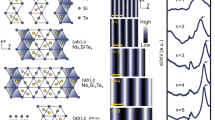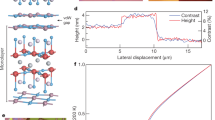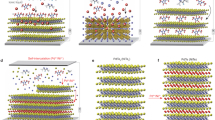Abstract
Reducing the dimensionality of layered materials can result in properties distinct from their bulk crystals1,2,3. However, the emergent properties in atomically thin samples, in particular in metallic monolayer flakes, are often obtained at the expense of other important properties. For example, while Ising superconductivity—where the pairing of electrons with opposite out-of-plane spins from K and K′ valleys leads to an in-plane upper critical field exceeding the Pauli limit—does not occur in bulk NbSe2, it was observed in two-dimensional monolayer flakes4. However, the critical temperature was reduced as compared to bulk crystals4,5,6,7,8,9,10,11,12,13. Here we take a different route to control the superconducting properties of NbSe2 by intercalating bulk crystals with cations from ionic liquids. This produces Ising superconductivity with a similar critical temperature to the non-intercalated bulk and is more stable than in a monolayer flake. Our angle-resolved photoemission spectroscopy measurements reveal the effectively two-dimensional electronic structure, and a comparison of the experimental electronic structures between intercalated bulk NbSe2 and monolayer NbSe2 film reveals that the intercalant induces electron doping. This suggests ionic liquid cation intercalation is an effective technique for controlling both the dimensionality and the carrier concentration, allowing tailored properties exceeding both bulk crystals and monolayer samples.
This is a preview of subscription content, access via your institution
Access options
Access Nature and 54 other Nature Portfolio journals
Get Nature+, our best-value online-access subscription
$29.99 / 30 days
cancel any time
Subscribe to this journal
Receive 12 print issues and online access
$209.00 per year
only $17.42 per issue
Buy this article
- Purchase on Springer Link
- Instant access to full article PDF
Prices may be subject to local taxes which are calculated during checkout




Similar content being viewed by others
Data availability
Source data are available with this paper. Other data that support the findings of this study are available from the corresponding author upon reasonable request.
References
Wang, Q. H., Kalantar-Zadeh, K., Kis, A., Coleman, J. N. & Strano, M. S. Electronics and optoelectronics of two-dimensional transition metal dichalcogenides. Nat. Nanotechnol. 7, 699–712 (2012).
Chhowalla, M. et al. The chemistry of two-dimensional layered transition metal dichalcogenide nanosheets. Nat. Chem. 5, 263–275 (2013).
Manzeli, S., Ovchinnikov, D., Pasquier, D., Yazyev, O. V. & Kis, A. 2D transition metal dichalcogenides. Nat. Rev. Mater. 2, 17033 (2017).
Xi, X. et al. Ising pairing in superconducting NbSe2 atomic layers. Nat. Phys. 12, 139–143 (2016).
Frindt, R. Superconductivity in ultrathin NbSe2 layers. Phys. Rev. Lett. 28, 299–301 (1972).
Staley, N. E. et al. Electric field effect on superconductivity in atomically thin flakes of NbSe2. Phys. Rev. B 80, 184505 (2009).
Cao, Y. et al. Quality heterostructures from two-dimensional crystals unstable in air by their assembly in inert atmosphere. Nano Lett. 15, 4914–4921 (2015).
Khestanova, E. et al. Unusual suppression of the superconducting energy gap and critical temperature in atomically thin NbSe2. Nano Lett. 18, 2623–2629 (2018).
Ugeda, M. M. et al. Characterization of collective ground states in single-layer NbSe2. Nat. Phys. 12, 92–97 (2015).
Xing, Y. et al. Ising superconductivity and quantum phase transition in macro-size monolayer NbSe2. Nano Lett. 17, 6802–6807 (2017).
Wang, H. et al. High-quality monolayer superconductor NbSe2 grown by chemical vapour deposition. Nat. Commun. 8, 394 (2017).
Nakata, Y. et al. Anisotropic band splitting in monolayer NbSe2: implications for superconductivity and charge density wave. npj 2D Mater. Appl. 2, 12 (2018).
Zhao, K. et al. Disorder-induced multifractal superconductivity in monolayer niobium dichalcogenides. Nat. Phys. 15, 904–910 (2019).
Yokoya, T. et al. Fermi surface sheet-dependent superconductivity in 2H-NbSe2. Science 294, 2518–2520 (2001).
Rahn, D. et al. Gaps and kinks in the electronic structure of the superconductor 2H-NbSe2 from angle-resolved photoemission at 1 K. Phys. Rev. B 85, 224532 (2012).
Xi, X. et al. Strongly enhanced charge-density-wave order in monolayer NbSe2. Nat. Nanotechnol. 10, 765–769 (2015).
Chu, C. W., Diatschenko, V., Huang, C. Y. & DiSalvo, F. J. Pressure effect on the charge-density-wave formation in 2H-NbSe2 and correlation between structural instabilities and superconductivity in unstable solids. Phys. Rev. B 15, 1340–1342 (1977).
Lian, C.-S., Chen, S. & Duan, W. Unveiling charge-density wave, superconductivity, and their competitive nature in two-dimensional NbSe2. Nano Lett. 18, 2924–2929 (2018).
Ueno, K. et al. Electric-field-induced superconductivity in an insulator. Nat. Mater. 7, 855–858 (2008).
Ueno, K. et al. Discovery of superconductivity in KTaO3 by electrostatic carrier doping. Nat. Nanotechnol. 6, 408–412 (2011).
Ye, J. T. et al. Superconducting dome in a gate-tuned band insulator. Science 338, 1193–1196 (2012).
Yamada, Y. et al. Electrically induced ferromagnetism at room temperature in cobalt-doped titanium dioxide. Science 332, 1065–1067 (2011).
Saito, Y. et al. Superconductivity protected by spin-valley locking in ion-gated MoS2. Nat. Phys. 12, 144–149 (2016).
Lu, J. et al. Evidence for two-dimensional Ising superconductivity in gated MoS2. Science 350, 1353–1357 (2015).
Zhang, H. et al. Enhancement of superconductivity in organic-inorganic hybrid topological materials. Sci. Bull. 65, 188–193 (2020).
Rousuli, A. et al. Induced anisotropic superconductivity in ionic liquid cation intercalated 1T-SnSe2. 2D Mater. 8, 015024 (2020).
Das, A. et al. Monitoring dopants by Raman scattering in an electrochemically top-gated graphene transistor. Nat. Nanotechnol. 3, 210–215 (2008).
Johannes, M., Mazin, I. & Howells, C. Fermi-surface nesting and the origin of the charge-density wave in NbSe2. Phys. Rev. B 73, 205102 (2006).
Calandra, M., Mazin, I. I. & Mauri, F. Effect of dimensionality on the charge-density wave in few-layer 2H-NbSe2. Phys. Rev. B 80, 308–310 (2009).
Sobota, J. A., He, Y. & Shen, Z.-X. Angle-resolved photoemission studies of quantum materials. Rev. Mod. Phys. 93, 025006 (2021).
Kirchner, S. et al. Colloquium: Heavy-electron quantum criticality and single-particle spectroscopy. Rev. Mod. Phys. 92, 011002 (2020).
Zhang, H. et al. Angle-resolved photoemission spectroscopy. Nat. Rev. Methods Primers 2, 54 (2022).
Luttinger, J. Fermi surface and some simple equilibrium properties of a system of interacting fermions. Phys. Rev. 119, 1153–1163 (1960).
Chandrasekhar, B. A note on the maximum critical field of high-field superconductors. Appl. Phys. Lett. 1, 7–8 (1962).
Clogston, A. M. Upper limit for the critical field in hard superconductors. Phys. Rev. Lett. 9, 266–267 (1962).
Wang, C. et al. Monolayer atomic crystal molecular superlattices. Nature 555, 231–236 (2018).
Simonin, J. Surface term in the superconductive Ginzburg–Landau free energy: application to thin films. Phys. Rev. B 33, 7830–7832 (1986).
de Gennes, P. G. Superconductivity of Metals and Alloys (Benjamin, New York, 1966).
Kresse, G. & Furthmüller, J. Efficiency of ab-initio total energy calculations for metals and semiconductors using a plane-wave basis set. Comput. Mater. Sci. 6, 15–50 (2019).
Perdew, J. P., Burke, K. & Ernzerhof, M. Generalized gradient approximation made simple. Phys. Rev. Lett. 77, 3865–3868 (1996).
Grimme, S., Antony, J., Ehrlich, S. & Krieg, H. A consistent and accurate ab initio parametrization of density functional dispersion correction (DFT-D) for the 94 elements H–Pu. J. Phys. Chem. Lett. 132, 154104 (2010).
Acknowledgements
The work is mainly supported by the Ministry of Science and Technology of China (Grant Nos. 2020YFA0308800, 2021YFA1400100, 2016YFA0301004) and National Natural Science Foundation of China (Grant No. 11725418). Y.W. is supported by the Fundamental Research Funds for the Central Universities (buctrc202212) and National Natural Science Foundation of China (Grant Nos. 21975140, 51991343). Y.X. is supported by the National Natural Science Foundation of China (Grant Nos. 12025405, 11874035) and the Ministry of Science and Technology of China (Grant Nos. 2018YFA0307100, 2018YFA0305603). S.J. and P.Y. are supported by the Ministry of Science and Technology of China (Grant No. 2021YFE0107900). P.Y. is also supported by the NSFC (Grant Nos. 52025024 and 51872155) and the Beijing Nature Science Foundation (Grant No. Z200007). Y.X., W.D. and P.Y. are supported by the Basic Science Center Program of NSFC (Grant No. 51788104).
Author information
Authors and Affiliations
Contributions
S.Z. and P.Y. conceived the research project. Haoxiong Zhang, A.R., C.G., L.L., R.F. and Y.W. grew, intercalated and characterized the samples. A.R., Haoxiong Zhang, Kenan Zhang, C.B., Hongyun Zhang and W.Y. performed the ARPES measurements and analysed the ARPES data. Haoxiong Zhang, S.S. and P.Y. performed the transport measurements. Kun Zhao., S.J., Xi Chen and Q.-K.X. grew the monolayer NbSe2 MBE film for ARPES measurements. Haoxiong Zhang, Xin Cong and P.T. performed the Raman measurements and analysed the Raman data. Z.L., S.X., Y.X. and W.D. performed the first-principles calculations. Haoxiong Zhang, P.Y. and S.Z. wrote the manuscript, and all authors commented on the manuscript.
Corresponding author
Ethics declarations
Competing interests
The authors declare no competing interests.
Peer review
Peer review information
Nature Physics thanks the anonymous reviewers for their contribution to the peer review of this work.
Additional information
Publisher’s note Springer Nature remains neutral with regard to jurisdictional claims in published maps and institutional affiliations.
Supplementary information
Supplementary Information
Supplementary Figs. 1–10, Discussion and Tables 1–2.
Source data
Rights and permissions
Springer Nature or its licensor holds exclusive rights to this article under a publishing agreement with the author(s) or other rightsholder(s); author self-archiving of the accepted manuscript version of this article is solely governed by the terms of such publishing agreement and applicable law.
About this article
Cite this article
Zhang, H., Rousuli, A., Zhang, K. et al. Tailored Ising superconductivity in intercalated bulk NbSe2. Nat. Phys. 18, 1425–1430 (2022). https://doi.org/10.1038/s41567-022-01778-7
Received:
Accepted:
Published:
Issue Date:
DOI: https://doi.org/10.1038/s41567-022-01778-7
This article is cited by
-
Direct visualization of stacking-selective self-intercalation in epitaxial Nb1+xSe2 films
Nature Communications (2024)
-
Ultrasmall single-layered NbSe2 nanotubes flattened within a chemical-driven self-pressurized carbon nanotube
Nature Communications (2024)
-
Superconductivity in unconventional metals
npj Computational Materials (2024)
-
Recent advances on liquid intercalation and exfoliation of transition metal dichalcogenides: From fundamentals to applications
Nano Research (2024)
-
Larger in-plane upper critical field and superconducting diode effect observed in topological superconductor candidate InNbS2 nanoribbons
Nano Research (2024)



